Road Organization: Impact of Structure and Culture on Healthcare
VerifiedAdded on 2023/06/03
|8
|1857
|92
Report
AI Summary
This report provides an analysis of the healthcare environment within Road Organization, focusing on the impact of its hierarchical structure on the organizational culture. It examines how the hierarchical structure, characterized by a top-down power dynamic, influences decision-making processes, task delegation, and overall organizational planning. The report also delves into the organization's role culture, highlighting its strengths in providing clarity and stability but also its limitations in adapting to change. Furthermore, the analysis identifies potential improvements, suggesting a shift towards a power or task culture and a transition to a professional organizational structure to enhance employee morale, promote equality, and foster a more interactive environment. The report concludes by emphasizing the importance of aligning organizational structure and culture to achieve organizational goals effectively.
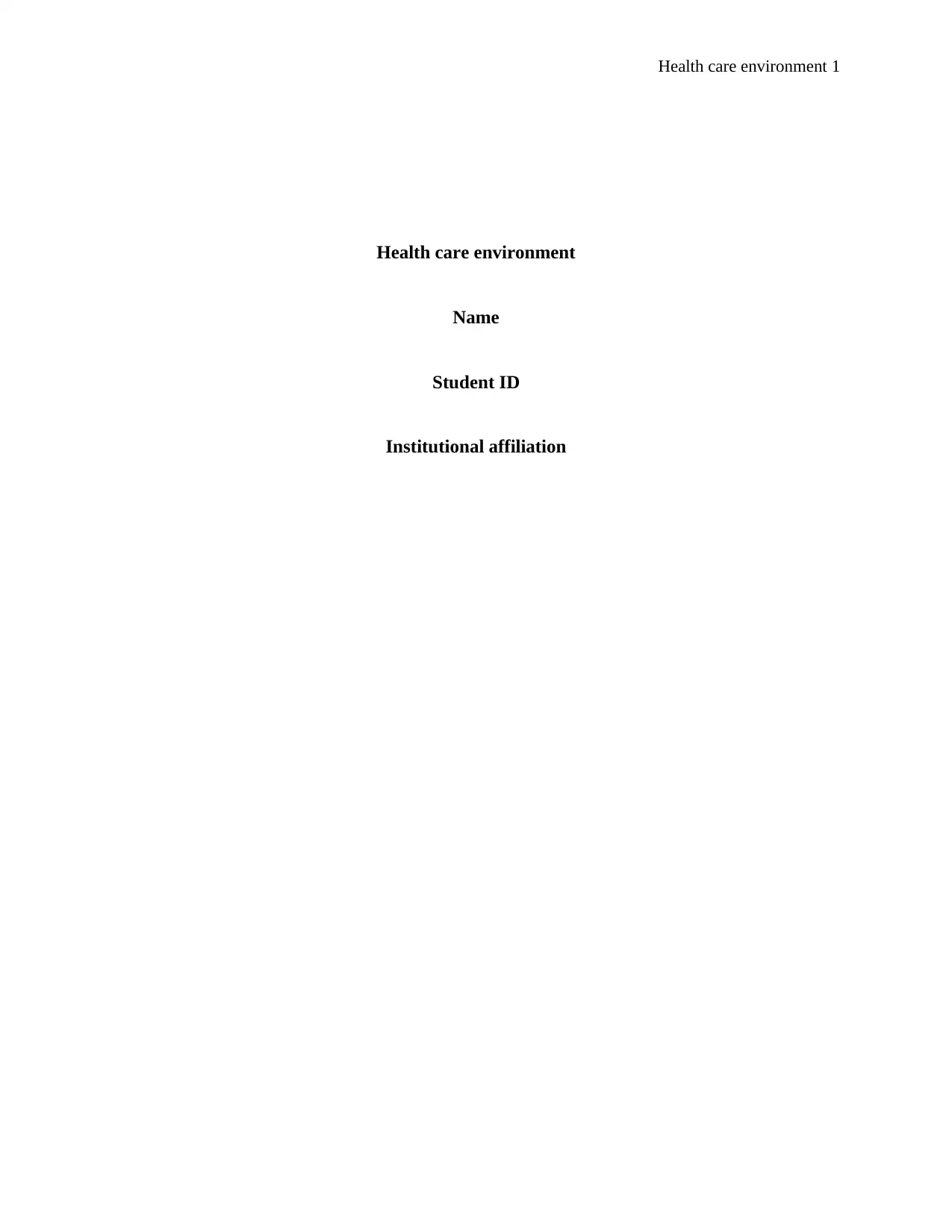
Health care environment 1
Health care environment
Name
Student ID
Institutional affiliation
Health care environment
Name
Student ID
Institutional affiliation
Paraphrase This Document
Need a fresh take? Get an instant paraphrase of this document with our AI Paraphraser
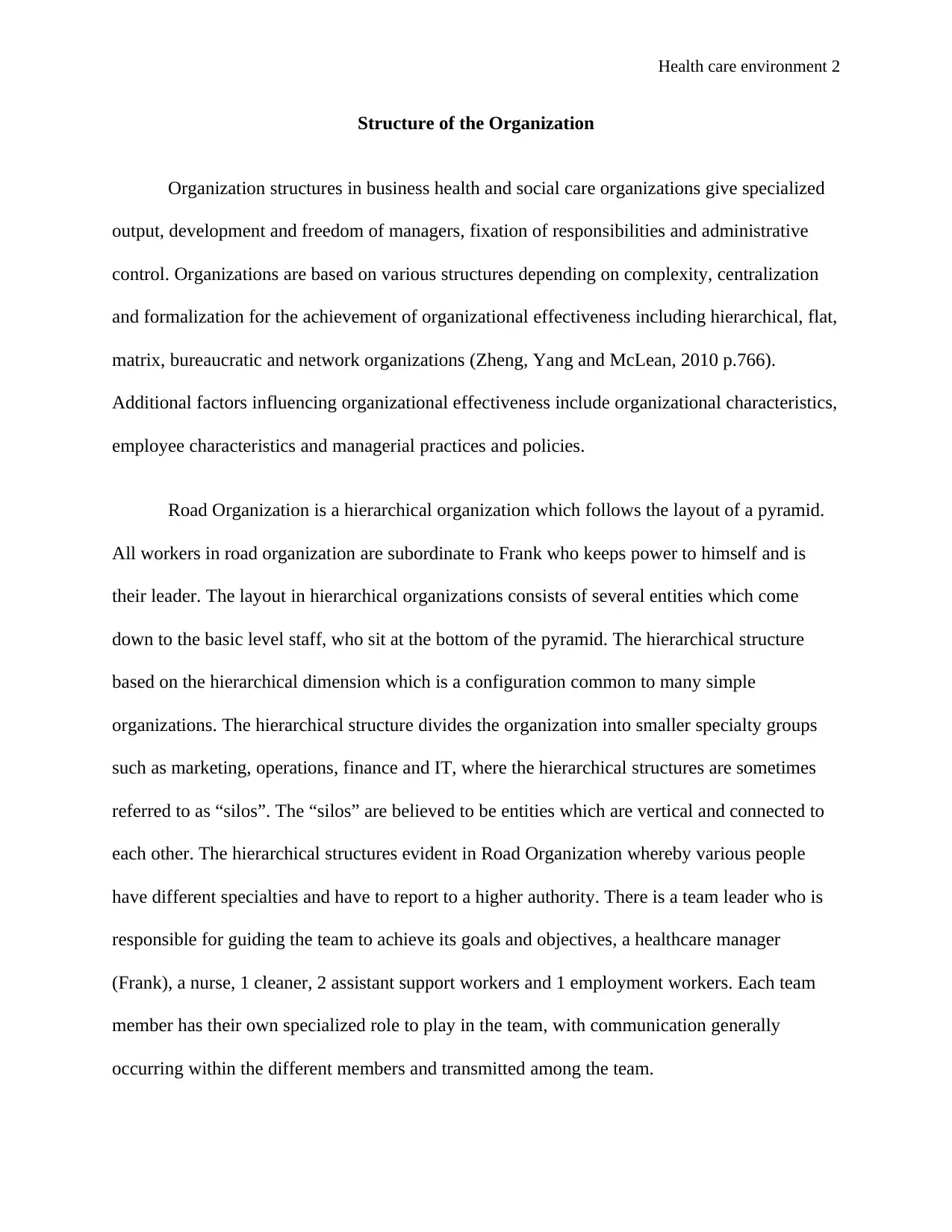
Health care environment 2
Structure of the Organization
Organization structures in business health and social care organizations give specialized
output, development and freedom of managers, fixation of responsibilities and administrative
control. Organizations are based on various structures depending on complexity, centralization
and formalization for the achievement of organizational effectiveness including hierarchical, flat,
matrix, bureaucratic and network organizations (Zheng, Yang and McLean, 2010 p.766).
Additional factors influencing organizational effectiveness include organizational characteristics,
employee characteristics and managerial practices and policies.
Road Organization is a hierarchical organization which follows the layout of a pyramid.
All workers in road organization are subordinate to Frank who keeps power to himself and is
their leader. The layout in hierarchical organizations consists of several entities which come
down to the basic level staff, who sit at the bottom of the pyramid. The hierarchical structure
based on the hierarchical dimension which is a configuration common to many simple
organizations. The hierarchical structure divides the organization into smaller specialty groups
such as marketing, operations, finance and IT, where the hierarchical structures are sometimes
referred to as “silos”. The “silos” are believed to be entities which are vertical and connected to
each other. The hierarchical structures evident in Road Organization whereby various people
have different specialties and have to report to a higher authority. There is a team leader who is
responsible for guiding the team to achieve its goals and objectives, a healthcare manager
(Frank), a nurse, 1 cleaner, 2 assistant support workers and 1 employment workers. Each team
member has their own specialized role to play in the team, with communication generally
occurring within the different members and transmitted among the team.
Structure of the Organization
Organization structures in business health and social care organizations give specialized
output, development and freedom of managers, fixation of responsibilities and administrative
control. Organizations are based on various structures depending on complexity, centralization
and formalization for the achievement of organizational effectiveness including hierarchical, flat,
matrix, bureaucratic and network organizations (Zheng, Yang and McLean, 2010 p.766).
Additional factors influencing organizational effectiveness include organizational characteristics,
employee characteristics and managerial practices and policies.
Road Organization is a hierarchical organization which follows the layout of a pyramid.
All workers in road organization are subordinate to Frank who keeps power to himself and is
their leader. The layout in hierarchical organizations consists of several entities which come
down to the basic level staff, who sit at the bottom of the pyramid. The hierarchical structure
based on the hierarchical dimension which is a configuration common to many simple
organizations. The hierarchical structure divides the organization into smaller specialty groups
such as marketing, operations, finance and IT, where the hierarchical structures are sometimes
referred to as “silos”. The “silos” are believed to be entities which are vertical and connected to
each other. The hierarchical structures evident in Road Organization whereby various people
have different specialties and have to report to a higher authority. There is a team leader who is
responsible for guiding the team to achieve its goals and objectives, a healthcare manager
(Frank), a nurse, 1 cleaner, 2 assistant support workers and 1 employment workers. Each team
member has their own specialized role to play in the team, with communication generally
occurring within the different members and transmitted among the team.
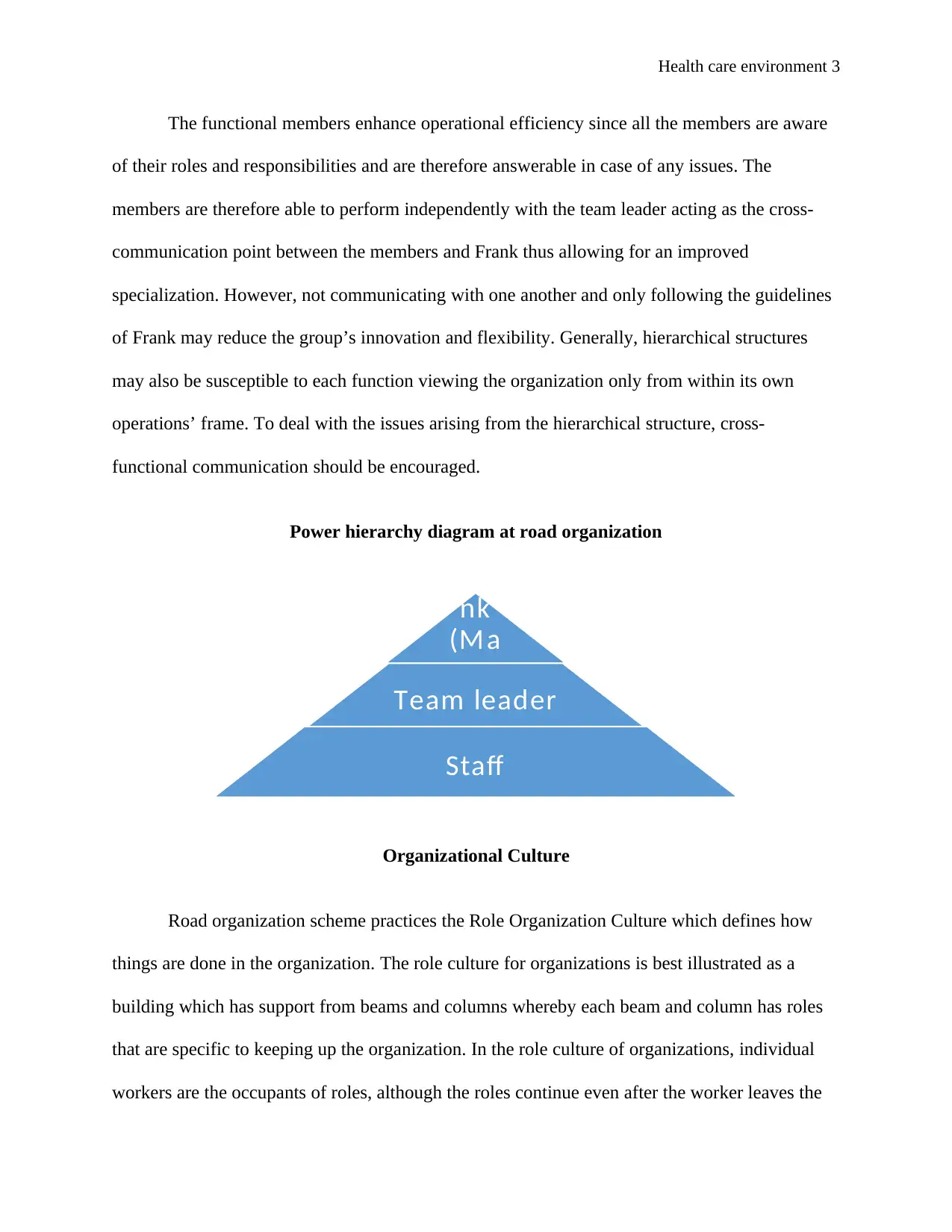
Health care environment 3
The functional members enhance operational efficiency since all the members are aware
of their roles and responsibilities and are therefore answerable in case of any issues. The
members are therefore able to perform independently with the team leader acting as the cross-
communication point between the members and Frank thus allowing for an improved
specialization. However, not communicating with one another and only following the guidelines
of Frank may reduce the group’s innovation and flexibility. Generally, hierarchical structures
may also be susceptible to each function viewing the organization only from within its own
operations’ frame. To deal with the issues arising from the hierarchical structure, cross-
functional communication should be encouraged.
Power hierarchy diagram at road organization
Organizational Culture
Road organization scheme practices the Role Organization Culture which defines how
things are done in the organization. The role culture for organizations is best illustrated as a
building which has support from beams and columns whereby each beam and column has roles
that are specific to keeping up the organization. In the role culture of organizations, individual
workers are the occupants of roles, although the roles continue even after the worker leaves the
Fra
nk
(Ma
nag
er)Team leader
Staff
The functional members enhance operational efficiency since all the members are aware
of their roles and responsibilities and are therefore answerable in case of any issues. The
members are therefore able to perform independently with the team leader acting as the cross-
communication point between the members and Frank thus allowing for an improved
specialization. However, not communicating with one another and only following the guidelines
of Frank may reduce the group’s innovation and flexibility. Generally, hierarchical structures
may also be susceptible to each function viewing the organization only from within its own
operations’ frame. To deal with the issues arising from the hierarchical structure, cross-
functional communication should be encouraged.
Power hierarchy diagram at road organization
Organizational Culture
Road organization scheme practices the Role Organization Culture which defines how
things are done in the organization. The role culture for organizations is best illustrated as a
building which has support from beams and columns whereby each beam and column has roles
that are specific to keeping up the organization. In the role culture of organizations, individual
workers are the occupants of roles, although the roles continue even after the worker leaves the
Fra
nk
(Ma
nag
er)Team leader
Staff
⊘ This is a preview!⊘
Do you want full access?
Subscribe today to unlock all pages.

Trusted by 1+ million students worldwide
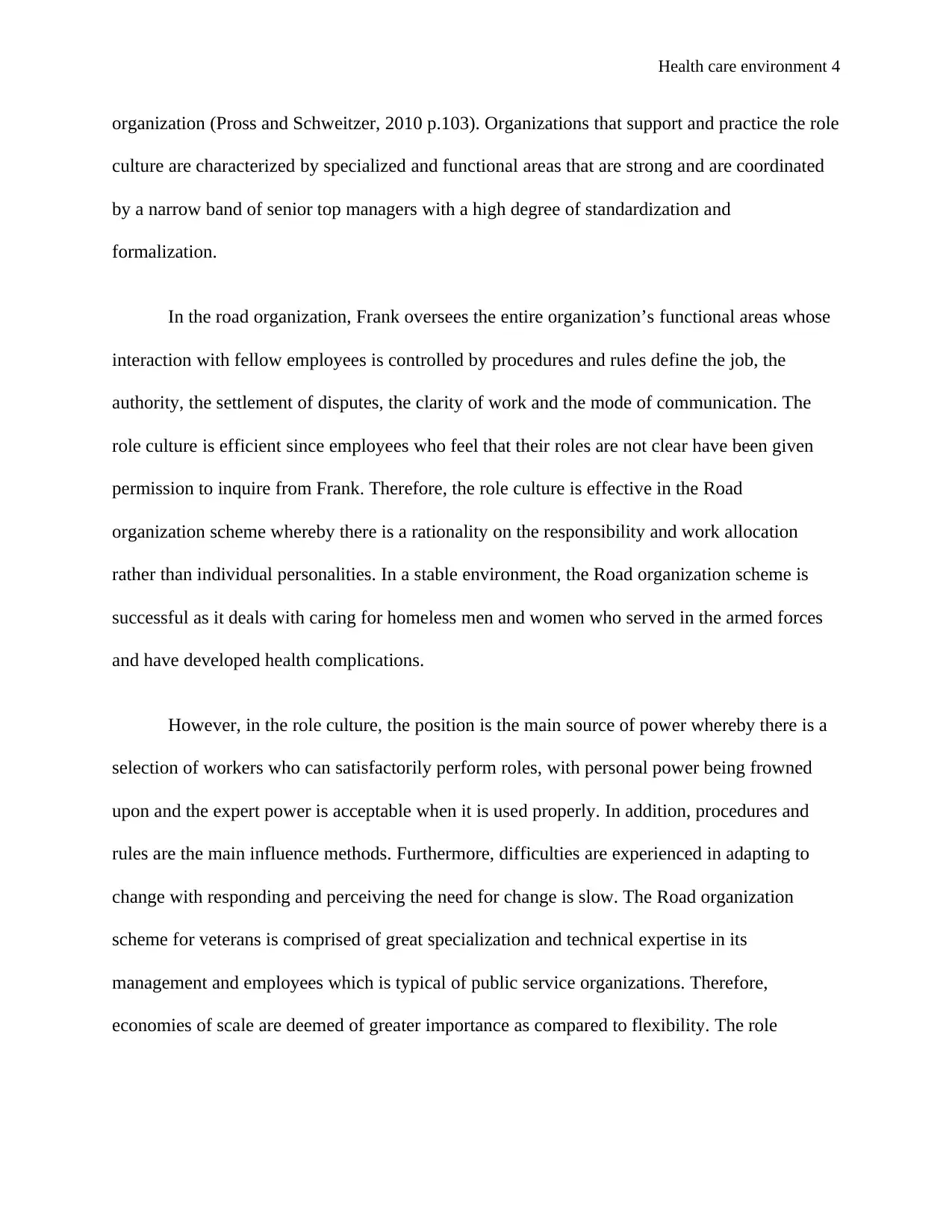
Health care environment 4
organization (Pross and Schweitzer, 2010 p.103). Organizations that support and practice the role
culture are characterized by specialized and functional areas that are strong and are coordinated
by a narrow band of senior top managers with a high degree of standardization and
formalization.
In the road organization, Frank oversees the entire organization’s functional areas whose
interaction with fellow employees is controlled by procedures and rules define the job, the
authority, the settlement of disputes, the clarity of work and the mode of communication. The
role culture is efficient since employees who feel that their roles are not clear have been given
permission to inquire from Frank. Therefore, the role culture is effective in the Road
organization scheme whereby there is a rationality on the responsibility and work allocation
rather than individual personalities. In a stable environment, the Road organization scheme is
successful as it deals with caring for homeless men and women who served in the armed forces
and have developed health complications.
However, in the role culture, the position is the main source of power whereby there is a
selection of workers who can satisfactorily perform roles, with personal power being frowned
upon and the expert power is acceptable when it is used properly. In addition, procedures and
rules are the main influence methods. Furthermore, difficulties are experienced in adapting to
change with responding and perceiving the need for change is slow. The Road organization
scheme for veterans is comprised of great specialization and technical expertise in its
management and employees which is typical of public service organizations. Therefore,
economies of scale are deemed of greater importance as compared to flexibility. The role
organization (Pross and Schweitzer, 2010 p.103). Organizations that support and practice the role
culture are characterized by specialized and functional areas that are strong and are coordinated
by a narrow band of senior top managers with a high degree of standardization and
formalization.
In the road organization, Frank oversees the entire organization’s functional areas whose
interaction with fellow employees is controlled by procedures and rules define the job, the
authority, the settlement of disputes, the clarity of work and the mode of communication. The
role culture is efficient since employees who feel that their roles are not clear have been given
permission to inquire from Frank. Therefore, the role culture is effective in the Road
organization scheme whereby there is a rationality on the responsibility and work allocation
rather than individual personalities. In a stable environment, the Road organization scheme is
successful as it deals with caring for homeless men and women who served in the armed forces
and have developed health complications.
However, in the role culture, the position is the main source of power whereby there is a
selection of workers who can satisfactorily perform roles, with personal power being frowned
upon and the expert power is acceptable when it is used properly. In addition, procedures and
rules are the main influence methods. Furthermore, difficulties are experienced in adapting to
change with responding and perceiving the need for change is slow. The Road organization
scheme for veterans is comprised of great specialization and technical expertise in its
management and employees which is typical of public service organizations. Therefore,
economies of scale are deemed of greater importance as compared to flexibility. The role
Paraphrase This Document
Need a fresh take? Get an instant paraphrase of this document with our AI Paraphraser
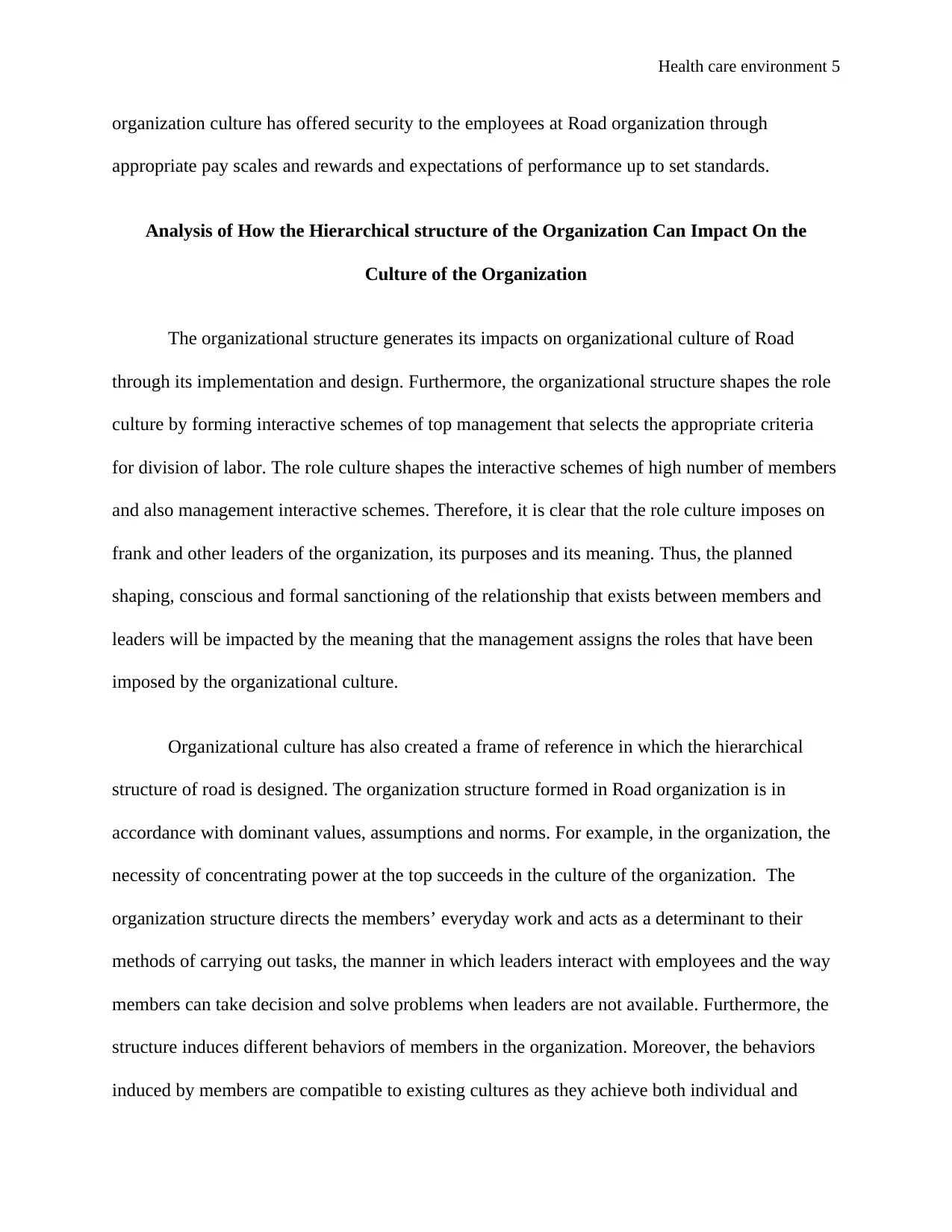
Health care environment 5
organization culture has offered security to the employees at Road organization through
appropriate pay scales and rewards and expectations of performance up to set standards.
Analysis of How the Hierarchical structure of the Organization Can Impact On the
Culture of the Organization
The organizational structure generates its impacts on organizational culture of Road
through its implementation and design. Furthermore, the organizational structure shapes the role
culture by forming interactive schemes of top management that selects the appropriate criteria
for division of labor. The role culture shapes the interactive schemes of high number of members
and also management interactive schemes. Therefore, it is clear that the role culture imposes on
frank and other leaders of the organization, its purposes and its meaning. Thus, the planned
shaping, conscious and formal sanctioning of the relationship that exists between members and
leaders will be impacted by the meaning that the management assigns the roles that have been
imposed by the organizational culture.
Organizational culture has also created a frame of reference in which the hierarchical
structure of road is designed. The organization structure formed in Road organization is in
accordance with dominant values, assumptions and norms. For example, in the organization, the
necessity of concentrating power at the top succeeds in the culture of the organization. The
organization structure directs the members’ everyday work and acts as a determinant to their
methods of carrying out tasks, the manner in which leaders interact with employees and the way
members can take decision and solve problems when leaders are not available. Furthermore, the
structure induces different behaviors of members in the organization. Moreover, the behaviors
induced by members are compatible to existing cultures as they achieve both individual and
organization culture has offered security to the employees at Road organization through
appropriate pay scales and rewards and expectations of performance up to set standards.
Analysis of How the Hierarchical structure of the Organization Can Impact On the
Culture of the Organization
The organizational structure generates its impacts on organizational culture of Road
through its implementation and design. Furthermore, the organizational structure shapes the role
culture by forming interactive schemes of top management that selects the appropriate criteria
for division of labor. The role culture shapes the interactive schemes of high number of members
and also management interactive schemes. Therefore, it is clear that the role culture imposes on
frank and other leaders of the organization, its purposes and its meaning. Thus, the planned
shaping, conscious and formal sanctioning of the relationship that exists between members and
leaders will be impacted by the meaning that the management assigns the roles that have been
imposed by the organizational culture.
Organizational culture has also created a frame of reference in which the hierarchical
structure of road is designed. The organization structure formed in Road organization is in
accordance with dominant values, assumptions and norms. For example, in the organization, the
necessity of concentrating power at the top succeeds in the culture of the organization. The
organization structure directs the members’ everyday work and acts as a determinant to their
methods of carrying out tasks, the manner in which leaders interact with employees and the way
members can take decision and solve problems when leaders are not available. Furthermore, the
structure induces different behaviors of members in the organization. Moreover, the behaviors
induced by members are compatible to existing cultures as they achieve both individual and
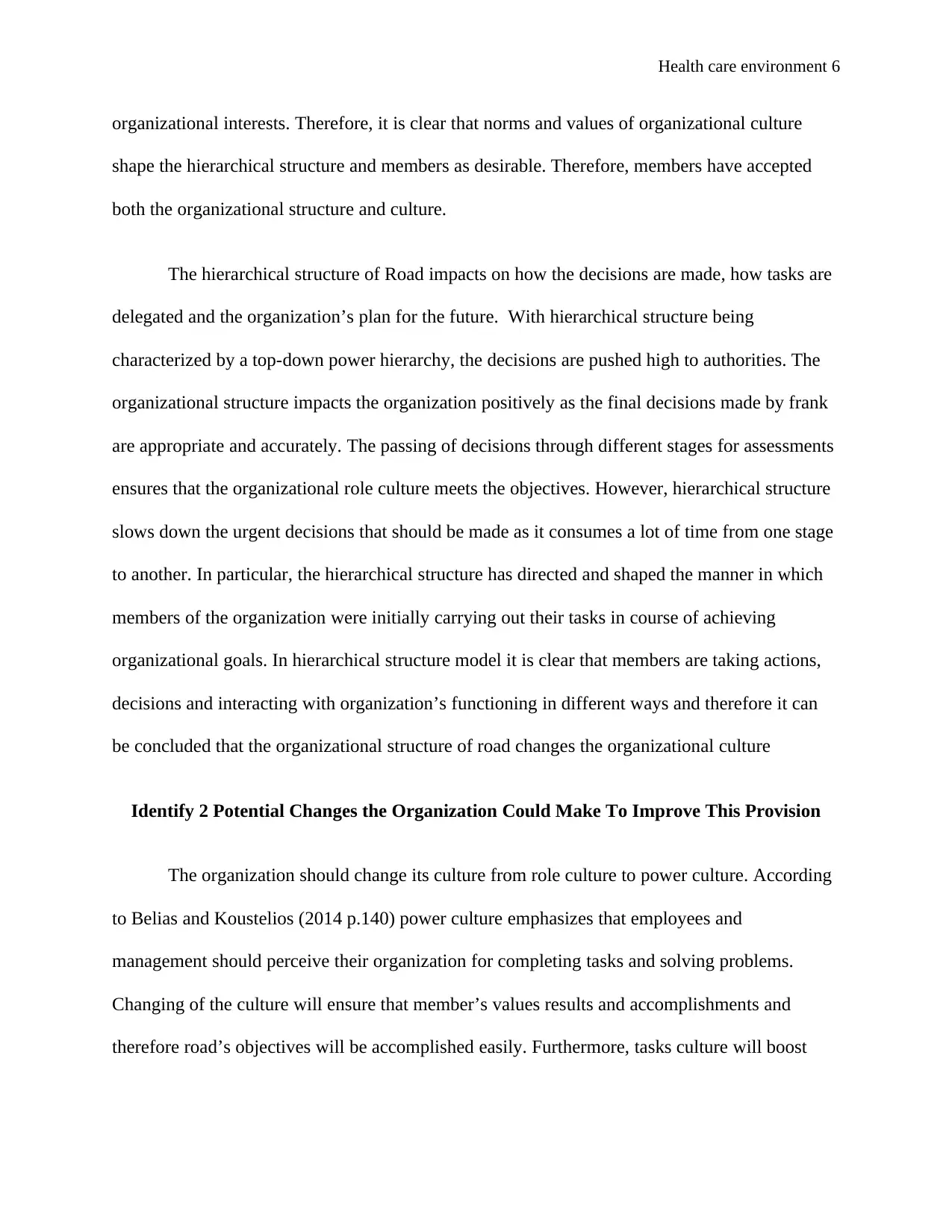
Health care environment 6
organizational interests. Therefore, it is clear that norms and values of organizational culture
shape the hierarchical structure and members as desirable. Therefore, members have accepted
both the organizational structure and culture.
The hierarchical structure of Road impacts on how the decisions are made, how tasks are
delegated and the organization’s plan for the future. With hierarchical structure being
characterized by a top-down power hierarchy, the decisions are pushed high to authorities. The
organizational structure impacts the organization positively as the final decisions made by frank
are appropriate and accurately. The passing of decisions through different stages for assessments
ensures that the organizational role culture meets the objectives. However, hierarchical structure
slows down the urgent decisions that should be made as it consumes a lot of time from one stage
to another. In particular, the hierarchical structure has directed and shaped the manner in which
members of the organization were initially carrying out their tasks in course of achieving
organizational goals. In hierarchical structure model it is clear that members are taking actions,
decisions and interacting with organization’s functioning in different ways and therefore it can
be concluded that the organizational structure of road changes the organizational culture
Identify 2 Potential Changes the Organization Could Make To Improve This Provision
The organization should change its culture from role culture to power culture. According
to Belias and Koustelios (2014 p.140) power culture emphasizes that employees and
management should perceive their organization for completing tasks and solving problems.
Changing of the culture will ensure that member’s values results and accomplishments and
therefore road’s objectives will be accomplished easily. Furthermore, tasks culture will boost
organizational interests. Therefore, it is clear that norms and values of organizational culture
shape the hierarchical structure and members as desirable. Therefore, members have accepted
both the organizational structure and culture.
The hierarchical structure of Road impacts on how the decisions are made, how tasks are
delegated and the organization’s plan for the future. With hierarchical structure being
characterized by a top-down power hierarchy, the decisions are pushed high to authorities. The
organizational structure impacts the organization positively as the final decisions made by frank
are appropriate and accurately. The passing of decisions through different stages for assessments
ensures that the organizational role culture meets the objectives. However, hierarchical structure
slows down the urgent decisions that should be made as it consumes a lot of time from one stage
to another. In particular, the hierarchical structure has directed and shaped the manner in which
members of the organization were initially carrying out their tasks in course of achieving
organizational goals. In hierarchical structure model it is clear that members are taking actions,
decisions and interacting with organization’s functioning in different ways and therefore it can
be concluded that the organizational structure of road changes the organizational culture
Identify 2 Potential Changes the Organization Could Make To Improve This Provision
The organization should change its culture from role culture to power culture. According
to Belias and Koustelios (2014 p.140) power culture emphasizes that employees and
management should perceive their organization for completing tasks and solving problems.
Changing of the culture will ensure that member’s values results and accomplishments and
therefore road’s objectives will be accomplished easily. Furthermore, tasks culture will boost
⊘ This is a preview!⊘
Do you want full access?
Subscribe today to unlock all pages.

Trusted by 1+ million students worldwide
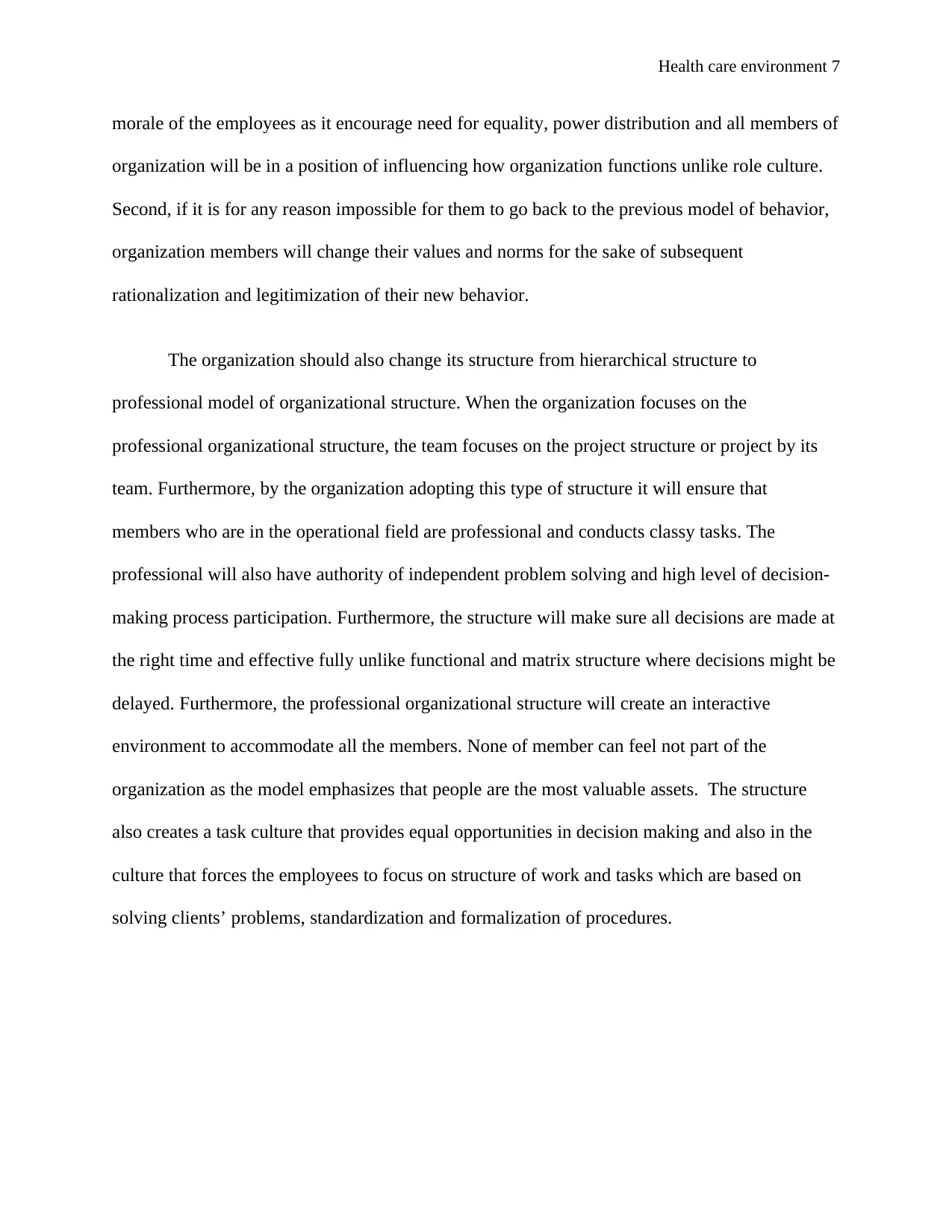
Health care environment 7
morale of the employees as it encourage need for equality, power distribution and all members of
organization will be in a position of influencing how organization functions unlike role culture.
Second, if it is for any reason impossible for them to go back to the previous model of behavior,
organization members will change their values and norms for the sake of subsequent
rationalization and legitimization of their new behavior.
The organization should also change its structure from hierarchical structure to
professional model of organizational structure. When the organization focuses on the
professional organizational structure, the team focuses on the project structure or project by its
team. Furthermore, by the organization adopting this type of structure it will ensure that
members who are in the operational field are professional and conducts classy tasks. The
professional will also have authority of independent problem solving and high level of decision-
making process participation. Furthermore, the structure will make sure all decisions are made at
the right time and effective fully unlike functional and matrix structure where decisions might be
delayed. Furthermore, the professional organizational structure will create an interactive
environment to accommodate all the members. None of member can feel not part of the
organization as the model emphasizes that people are the most valuable assets. The structure
also creates a task culture that provides equal opportunities in decision making and also in the
culture that forces the employees to focus on structure of work and tasks which are based on
solving clients’ problems, standardization and formalization of procedures.
morale of the employees as it encourage need for equality, power distribution and all members of
organization will be in a position of influencing how organization functions unlike role culture.
Second, if it is for any reason impossible for them to go back to the previous model of behavior,
organization members will change their values and norms for the sake of subsequent
rationalization and legitimization of their new behavior.
The organization should also change its structure from hierarchical structure to
professional model of organizational structure. When the organization focuses on the
professional organizational structure, the team focuses on the project structure or project by its
team. Furthermore, by the organization adopting this type of structure it will ensure that
members who are in the operational field are professional and conducts classy tasks. The
professional will also have authority of independent problem solving and high level of decision-
making process participation. Furthermore, the structure will make sure all decisions are made at
the right time and effective fully unlike functional and matrix structure where decisions might be
delayed. Furthermore, the professional organizational structure will create an interactive
environment to accommodate all the members. None of member can feel not part of the
organization as the model emphasizes that people are the most valuable assets. The structure
also creates a task culture that provides equal opportunities in decision making and also in the
culture that forces the employees to focus on structure of work and tasks which are based on
solving clients’ problems, standardization and formalization of procedures.
Paraphrase This Document
Need a fresh take? Get an instant paraphrase of this document with our AI Paraphraser
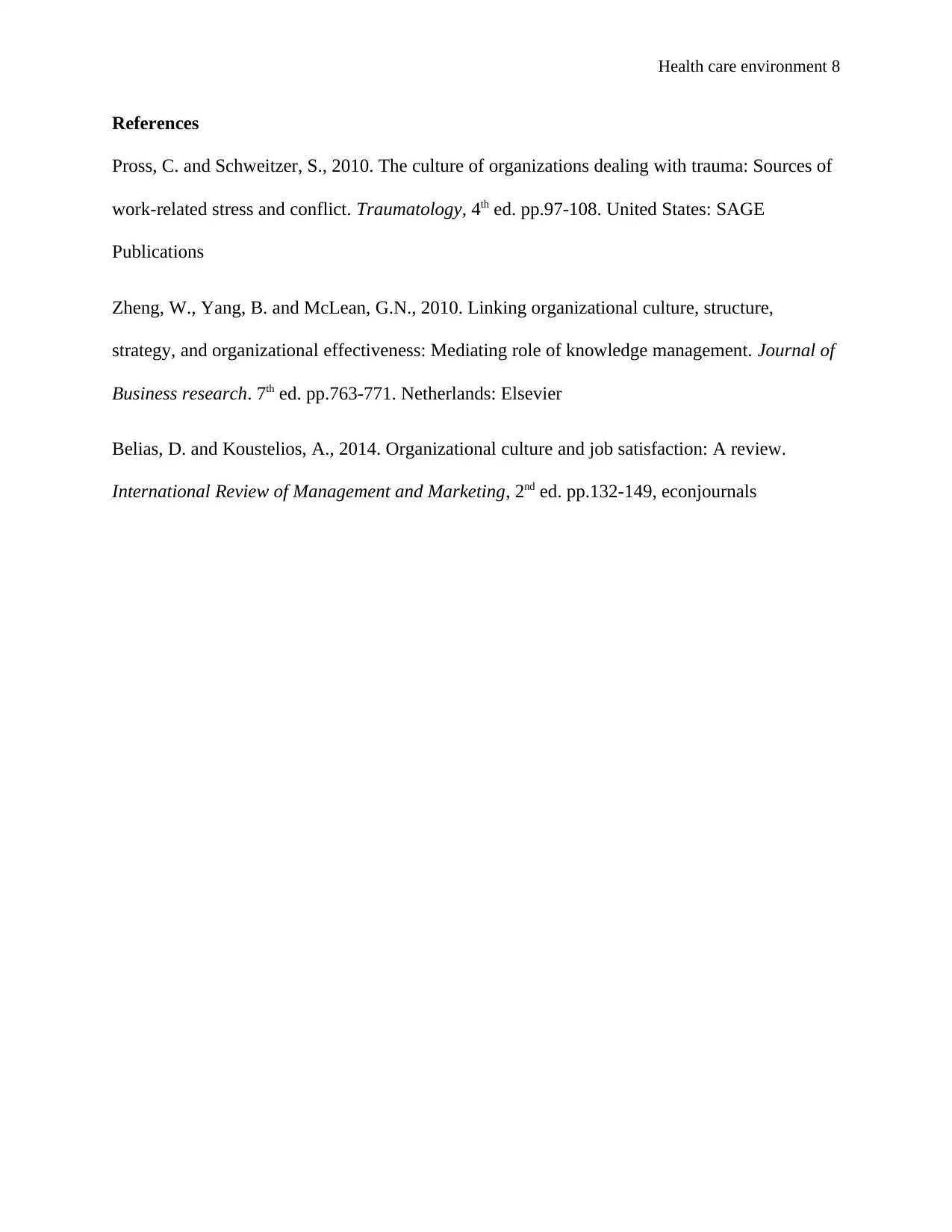
Health care environment 8
References
Pross, C. and Schweitzer, S., 2010. The culture of organizations dealing with trauma: Sources of
work-related stress and conflict. Traumatology, 4th ed. pp.97-108. United States: SAGE
Publications
Zheng, W., Yang, B. and McLean, G.N., 2010. Linking organizational culture, structure,
strategy, and organizational effectiveness: Mediating role of knowledge management. Journal of
Business research. 7th ed. pp.763-771. Netherlands: Elsevier
Belias, D. and Koustelios, A., 2014. Organizational culture and job satisfaction: A review.
International Review of Management and Marketing, 2nd ed. pp.132-149, econjournals
References
Pross, C. and Schweitzer, S., 2010. The culture of organizations dealing with trauma: Sources of
work-related stress and conflict. Traumatology, 4th ed. pp.97-108. United States: SAGE
Publications
Zheng, W., Yang, B. and McLean, G.N., 2010. Linking organizational culture, structure,
strategy, and organizational effectiveness: Mediating role of knowledge management. Journal of
Business research. 7th ed. pp.763-771. Netherlands: Elsevier
Belias, D. and Koustelios, A., 2014. Organizational culture and job satisfaction: A review.
International Review of Management and Marketing, 2nd ed. pp.132-149, econjournals
1 out of 8
Related Documents
Your All-in-One AI-Powered Toolkit for Academic Success.
+13062052269
info@desklib.com
Available 24*7 on WhatsApp / Email
![[object Object]](/_next/static/media/star-bottom.7253800d.svg)
Unlock your academic potential
Copyright © 2020–2025 A2Z Services. All Rights Reserved. Developed and managed by ZUCOL.





